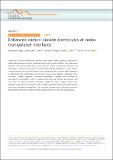Files in this item
Enhanced carbon dioxide electrolysis at redox manipulated interfaces
Item metadata
| dc.contributor.author | Wang, Wenyuan | |
| dc.contributor.author | Gan, Lizhen | |
| dc.contributor.author | Lemmon, John P. | |
| dc.contributor.author | Chen, Fanglin | |
| dc.contributor.author | Irvine, John T. S. | |
| dc.contributor.author | Xie, Kui | |
| dc.date.accessioned | 2019-04-08T10:30:04Z | |
| dc.date.available | 2019-04-08T10:30:04Z | |
| dc.date.issued | 2019-04-04 | |
| dc.identifier | 258517979 | |
| dc.identifier | 6483dd2b-f8f6-4fb3-a6b7-52f7a8c6e0ef | |
| dc.identifier | 85063985627 | |
| dc.identifier | 000463313200026 | |
| dc.identifier.citation | Wang , W , Gan , L , Lemmon , J P , Chen , F , Irvine , J T S & Xie , K 2019 , ' Enhanced carbon dioxide electrolysis at redox manipulated interfaces ' , Nature Communications , vol. 10 , 1550 . https://doi.org/10.1038/s41467-019-09568-1 | en |
| dc.identifier.issn | 2041-1723 | |
| dc.identifier.other | RIS: urn:650C87E27934826E918535E48E7B4A66 | |
| dc.identifier.other | RIS: Wang2019 | |
| dc.identifier.other | ORCID: /0000-0002-8394-3359/work/68280710 | |
| dc.identifier.uri | https://hdl.handle.net/10023/17478 | |
| dc.description | K.X. would like to acknowledge the funding support form Natural Science Foundation of China (91845202, 21750110433), Dalian National Laboratory for Clean Energy (DNL180404), and Strategic Priority Research Program of Chinese Academy of Sciences (XDB2000000). J.T.S.I. would like to acknowledge support from the EPSRC for the Emergent Nanomaterials Critical Mass project (EP/R023603/1). | en |
| dc.description.abstract | Utilization of carbon dioxide from industrial waste streams offers significant reductions in global carbon dioxide emissions. Solid oxide electrolysis is a highly efficient, high temperature approach that reduces polarization losses and best utilizes process heat; however, the technology is relatively unrefined for currently carbon dioxide electrolysis. In most electrochemical systems, the interface between active components are usually of great importance in determining the performance and lifetime of any energy materials application. Here we report a generic approach of interface engineering to achieve active interfaces at nanoscale by a synergistic control of materials functions and interface architectures. We show that the redox-manipulated interfaces facilitate the atomic oxygen transfer from adsorbed carbon dioxide molecules to the cathode lattice that determines carbon dioxide electrolysis at elevated temperatures. The composite cathodes with in situ grown interfaces demonstrate significantly enhanced carbon dioxide electrolysis and improved durability. | |
| dc.format.extent | 10 | |
| dc.format.extent | 6577546 | |
| dc.language.iso | eng | |
| dc.relation.ispartof | Nature Communications | en |
| dc.subject | QD Chemistry | en |
| dc.subject | DAS | en |
| dc.subject.lcc | QD | en |
| dc.title | Enhanced carbon dioxide electrolysis at redox manipulated interfaces | en |
| dc.type | Journal article | en |
| dc.contributor.institution | University of St Andrews. School of Chemistry | en |
| dc.contributor.institution | University of St Andrews. Centre for Designer Quantum Materials | en |
| dc.contributor.institution | University of St Andrews. EaSTCHEM | en |
| dc.identifier.doi | https://doi.org/10.1038/s41467-019-09568-1 | |
| dc.description.status | Peer reviewed | en |
This item appears in the following Collection(s)
Items in the St Andrews Research Repository are protected by copyright, with all rights reserved, unless otherwise indicated.

